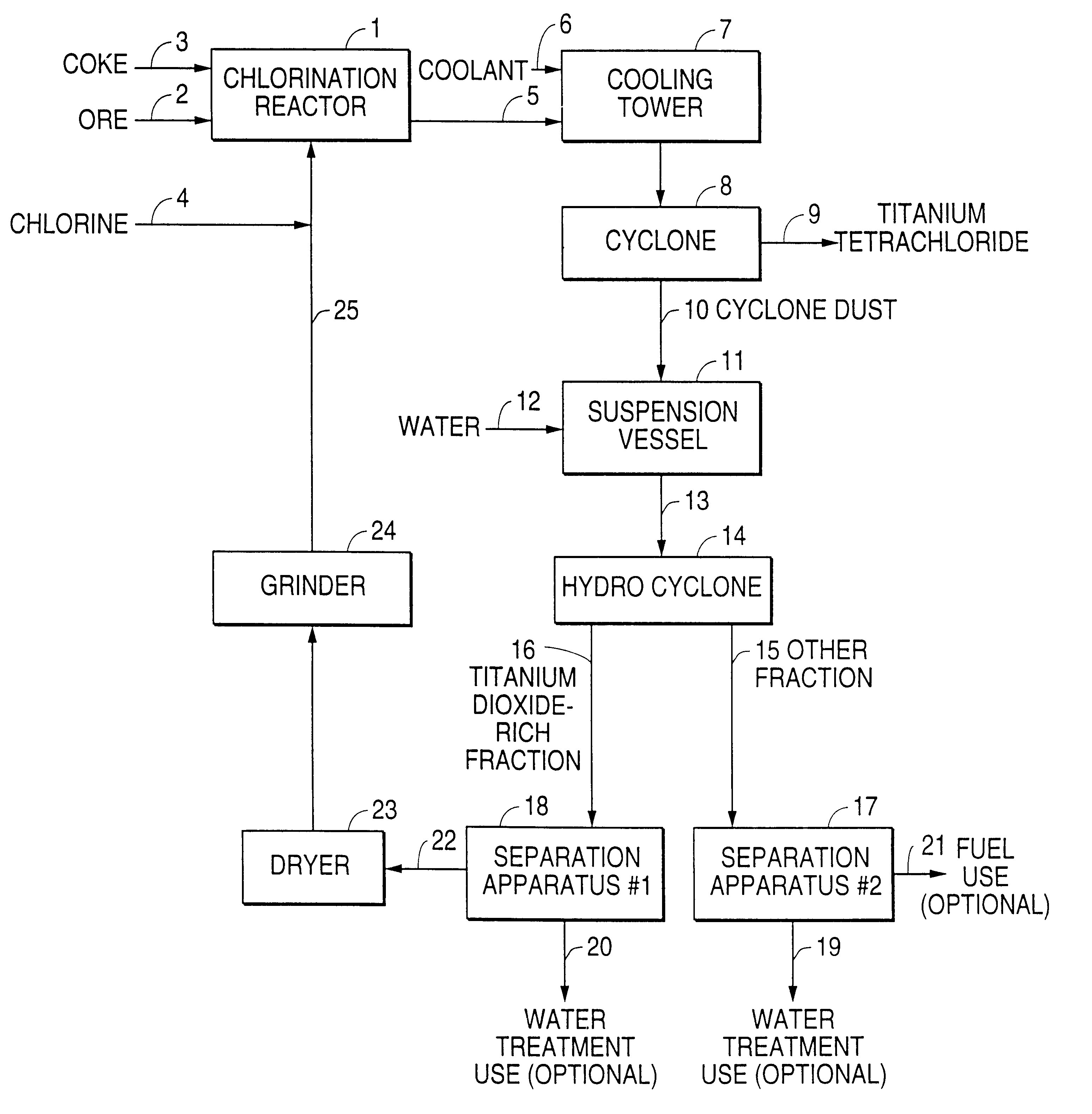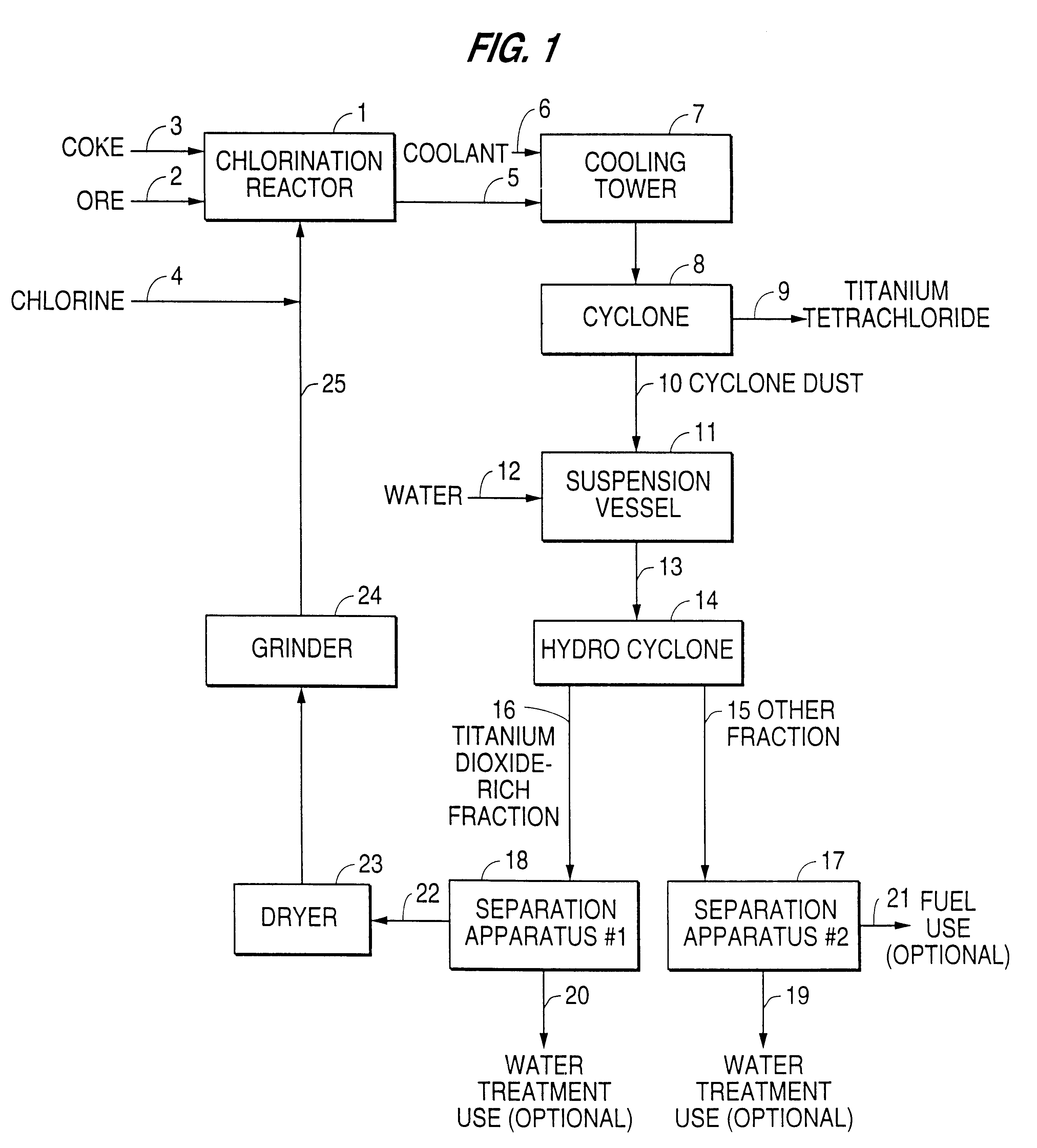Process for increasing the yield in the manufacture of titanium dioxide by the chloride process
a technology of chloride and titanium dioxide, which is applied in the direction of titanium dioxide, chemistry apparatus and processes, titanium compounds, etc., can solve the problems of increasing the operating cost of re-concentration and treatment, requiring additional process steps, etc., and achieves the reduction of silica and coke content, convenient and less expensive, and convenient operation.
- Summary
- Abstract
- Description
- Claims
- Application Information
AI Technical Summary
Benefits of technology
Problems solved by technology
Method used
Image
Examples
example 1
Prior Art
A fluidized-bed reactor was charged at 950.degree. C. with 7790 parts of slag (85% TiO.sub.2, 11% FeO, 1.6% SiO.sub.2), 2560 parts of coke and 12050 parts of chlorine gas, from which 14730 parts of titanium tetrachloride and 3755 parts of a solid mixture were formed. The solids mixture contained 2455 parts metal chlorides, in particular 1520 parts of iron(II) chloride, 415 parts of titanium dioxide, 765 parts of coke and 120 parts of quartz. The solids mixture was made into an aqueous paste suspension with 5300 parts of water, the suspension was filtered in a filter press and the filter cake washed. 1860 parts of cake were made having a water content of 30% by weight; after drying the cake had the following composition: coke 58.7% by weight, titanium dioxide 32% by weight, silica 9.3% by weight. The heating value of the material, because of the high ash content of 41.3%, was about 21300 kJ / kg.
example 2
Under the same starting conditions as in Example 1, a 6,740 liter suspension which contained 9050 parts of solids (having an iron content of 8.5% by weight) were applied to a battery of hydrocyclones (connected in parallel). The hydrocyclones 14 were characterized by the following parameters: diameter 75 mm, diameter of the overflow nozzle 18 mm, diameter of the underflow nozzle 6 mm. The feed pressure was 1.5 bar.sub.abs. The suspension had a temperature of 60.degree. C.
In the overflow of the hydrocyclone, a 6,020 liter suspension with 104 parts of TiO.sub.2, 490 parts of coke and 59 parts of SiO.sub.2 were discharged. In the underflow of the hydrocyclone a 720 liter suspension with 311 parts of TiO.sub.2, 275 parts of coke and 61 parts of SiO.sub.2 was discharged. The second suspension was filtered on a membrane filter press and washed. The washed cake was ground and dried at 90.degree. C. in a ball mill directly heated by combustion gases (D=1.2 m, 1=4 m). The ground product had ...
PUM
| Property | Measurement | Unit |
|---|---|---|
| Length | aaaaa | aaaaa |
| Fraction | aaaaa | aaaaa |
| Fraction | aaaaa | aaaaa |
Abstract
Description
Claims
Application Information
 Login to View More
Login to View More - R&D
- Intellectual Property
- Life Sciences
- Materials
- Tech Scout
- Unparalleled Data Quality
- Higher Quality Content
- 60% Fewer Hallucinations
Browse by: Latest US Patents, China's latest patents, Technical Efficacy Thesaurus, Application Domain, Technology Topic, Popular Technical Reports.
© 2025 PatSnap. All rights reserved.Legal|Privacy policy|Modern Slavery Act Transparency Statement|Sitemap|About US| Contact US: help@patsnap.com


